At WebsiteDesigner.Business, we believe in empowering kids with the skills they need to thrive in the digital age. That’s why we’re excited to explore the world of web design for kids, offering child-friendly and engaging platforms that foster creativity and problem-solving abilities.
Learning web design at a young age not only sparks the imagination but also cultivates important skills such as logical thinking, creativity, and problem-solving. With numerous online platforms and interactive tools available, kids can now embark on a journey of self-discovery, exploring the fascinating world of web development.
Key Takeaways:
- Web design for kids offers a fun and interactive way to develop creative skills and learn the basics of web development.
- Platforms like Scratch and Minecraft provide drag-and-drop interfaces and visual programming for kids to create interactive stories, animations, and games.
- LEGO WeDo combines engineering and robotics, allowing kids to build and program their own creations.
- Web Wonders introduces kids to web development and the basics of HTML and CSS.
- Design education and innovative platforms like Schoolopedia enhance the learning experience, teaching design principles and fostering creative thinking.
The Scratch Project: Creating Interactive Content for Kids
The Scratch project, developed by MIT Media Lab, aims to empower kids to develop their creativity and digital skills through engaging website design. Using the Scratch programming environment, kids can create and share interactive stories, games, and animations on the web. With a user-friendly interface, kids can easily snap together graphical programming blocks to control rich media content such as photos, graphics, music, and sound.
The Scratch project provides a platform for young audiences to express themselves creatively and learn important skills such as creative thinking and effective communication. By uploading their creations to the Scratch website, kids can interact with other members of the Scratch community, gain inspiration, and download the source code of projects. This fosters collaboration and encourages children to explore the vast possibilities of interactive design.
Through the Scratch project, kids can unleash their imaginations and turn their ideas into reality. Whether they want to create a virtual storybook, design a game, or bring a colorful animation to life, Scratch offers the tools and resources for them to do so. With its intuitive interface and supportive community, the Scratch project provides a safe and enjoyable environment for kids to learn, experiment, and share their creations.
Engaging Website Design for Children
One of the key strengths of the Scratch project is its engaging website design specifically tailored for children. The design elements are visually appealing, vibrant, and interactive, capturing the attention of young users and enhancing their overall experience. This user-friendly web design ensures that kids can easily navigate through the platform, find inspiration, and showcase their own creations.
The Scratch project understands the importance of creating an interactive design for young audiences. By incorporating features like drag-and-drop programming blocks and visual cues, kids can intuitively understand how to build and control their interactive projects. This interactive design encourages active participation, fosters engagement, and cultivates a sense of achievement as children see their ideas come to life.
Unlocking Creativity and Learning through User-Friendly Web Design for Kids
By providing a user-friendly web design, the Scratch project enables kids to focus on their creative process instead of getting lost in complex technicalities. The simplicity and adaptability of Scratch’s website design allow children to explore and experiment with different ideas, enhancing their problem-solving skills and fostering a sense of creative freedom.
The Scratch project’s user-friendly web design also promotes an inclusive and accessible learning experience for kids of all backgrounds and abilities. The design features clear instructions, tooltips, and visual cues that guide children through the process of creating interactive content. This approach allows kids to develop their digital literacy skills while gaining a foundation in programming concepts and computational thinking.
With the Scratch project’s engaging and user-friendly web design, children can embark on a journey of creativity, self-expression, and learning. Through their interactive creations, kids can tell stories, build games, and share their unique perspectives with a global community of young creators.
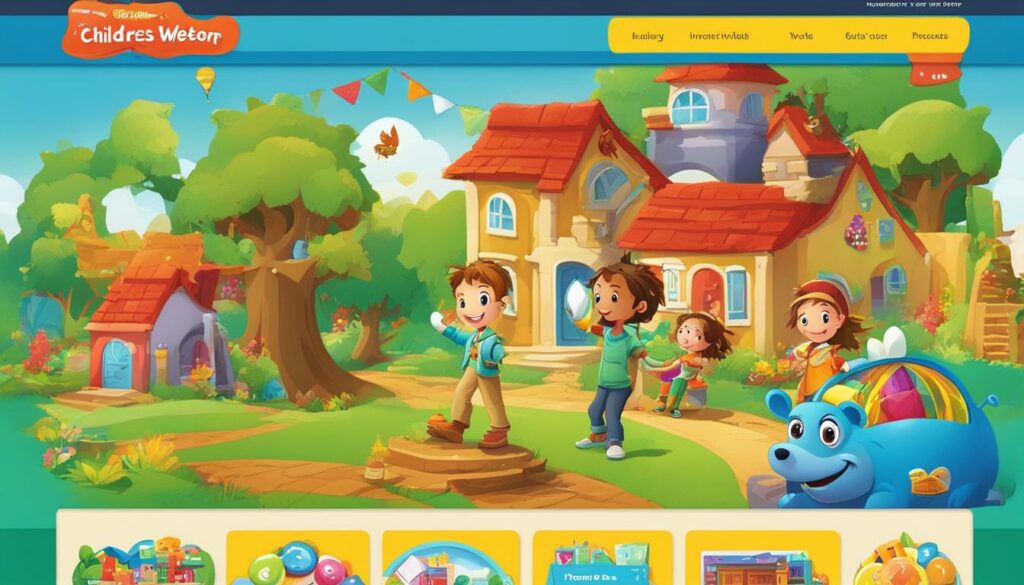
Minecraft Modding: Combining Creativity and Coding
Minecraft, a popular game among kids, offers a unique opportunity for them to learn web design and coding through modding. By customizing their Minecraft worlds and writing code to modify the game, kids can develop important skills while having fun.
Through Minecraft modding, children can unleash their creativity and explore the limitless possibilities of the game. They can create custom game elements, design their own levels, and even develop interactive features that enhance their gaming experience. This hands-on approach to web design and coding allows kids to develop logical thinking, problem-solving skills, and a keen eye for creative expression.
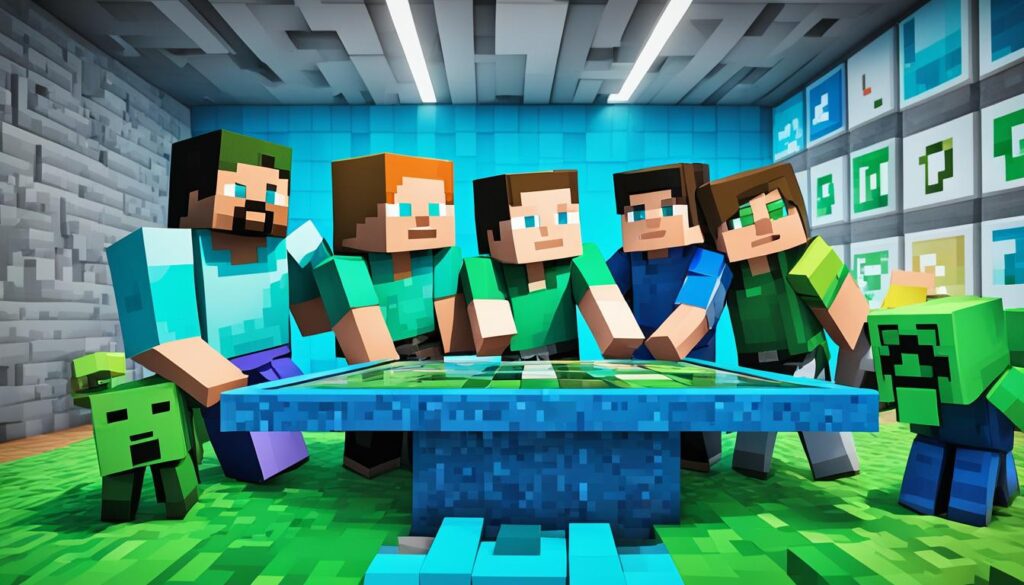
With Minecraft’s intuitive interface and the vast online community, kids can easily share and showcase their modding projects. This collaborative environment not only encourages teamwork but also provides a platform for kids to learn from others’ creations and gain inspiration for their own designs.
The immersive and engaging nature of Minecraft modding makes it an ideal tool for kids to learn web design and coding. By combining their passion for gaming with the world of coding, children can acquire valuable skills that will benefit them in the future.
“Minecraft modding allows kids to combine their creativity with coding, enabling them to express themselves and develop valuable skills in a familiar and enjoyable environment.”
Benefits of Minecraft Modding for Kids
Minecraft modding offers a range of benefits for children, including:
- Enhanced Problem-Solving Skills: By modifying the game, kids learn how to analyze problems and devise solutions through coding.
- Stimulated Creativity: The ability to create custom game elements allows kids to express their creativity and imagination.
- Improved Logical Thinking: Writing code to modify game behavior helps children develop logical thinking and sequence-based reasoning.
- Ownership and Empowerment: Creating custom features gives kids a sense of ownership and empowerment over their Minecraft worlds.
- Community Engagement: By sharing their modding projects with the Minecraft community, kids can learn from others and collaborate on new ideas.
Minecraft modding provides a bridge between gaming and coding, enabling kids to learn web design in a way that is fun, engaging, and interactive.
LEGO WeDo: Robotics and Engineering for Kids
LEGO WeDo is an educational platform that introduces kids to the exciting world of robotics and engineering through engaging and hands-on projects. With the use of LEGO elements, motors, and sensors, children can build their own creations and bring them to life by programming them using a visual interface.
LEGO WeDo goes beyond just building and playing with LEGO bricks. It provides kids with a comprehensive learning experience where they can explore engineering principles, learn basic programming concepts, and develop problem-solving skills. By combining creativity with hands-on learning, LEGO WeDo allows children to unleash their imagination and discover the power of robotics.
One popular project kids can undertake with LEGO WeDo is building and programming a robotic pet. They have the freedom to design the behavior and interactions of their creation, fostering their creativity and allowing them to take ownership of their robotic companions.
Through the LEGO WeDo platform, children can learn in a fun and interactive way, gaining valuable skills that will benefit them in various areas of their lives. Whether it’s fostering their logical thinking, encouraging team collaboration, or enhancing their understanding of programming and engineering, LEGO WeDo offers a well-rounded educational experience.
By engaging with LEGO WeDo, children are exposed to visually appealing website design for children and are introduced to the concept of creative web design. This allows them to explore the intersection of technology and design, igniting their passion for creating visually captivating websites that are tailored for young audiences.
With LEGO WeDo, children get the opportunity to embark on a journey where they can have fun while developing key skills for the future. It’s a gateway to a world of endless possibilities, where their creativity can thrive and their passion for robotics and engineering can flourish.
Explore the Possibilities with LEGO WeDo
Here are some key features and benefits of LEGO WeDo:
- Hands-on learning: Kids actively participate in the building and programming process, gaining practical knowledge and skills in robotics and engineering.
- Creative exploration: Children can unleash their imagination and design their own robotic creations, combining artistic expression with technical understanding.
- Problem-solving skills: LEGO WeDo challenges kids to find solutions to problems through trial and error, fostering critical thinking and perseverance.
- Visual programming interface: The easy-to-use visual interface allows children to program their creations without the need for complex coding, making it accessible and enjoyable for kids of all ages.
- Team collaboration: LEGO WeDo encourages cooperative learning and teamwork, promoting collaboration and communication skills.
LEGO WeDo is an ideal platform for children to engage with creative web design. By honing their engineering and programming skills, they can create visually appealing and interactive websites designed specifically for children.
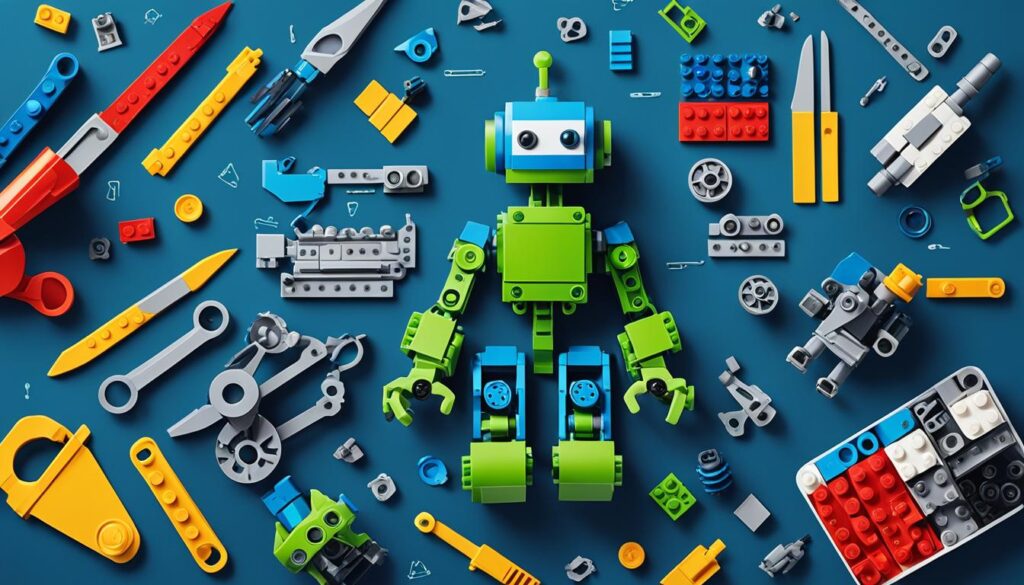
With LEGO WeDo, children not only gain a solid foundation in robotics and engineering, but also develop the creativity and technical skills necessary to create visually captivating websites for their young audiences.
Web Wonders: Introduction to Web Development for Kids
Web Wonders is a platform that introduces kids to the exciting world of web development and provides them with the essential knowledge of HTML and CSS. Through platforms like Thimble by Mozilla or Scratch, children can embark on a journey to create their own web pages and discover the magic of the internet.
At Web Wonders, kids learn the fundamentals of HTML and CSS, allowing them to understand the structure and layout of web pages. They also delve into design principles, learning how to create visually appealing and user-friendly websites. With interactive elements, children can unleash their creativity and engage visitors on their web pages.
One of the popular projects at Web Wonders is the creation of a digital story webpage. Kids get to design web pages that come alive with interactive elements, captivating visuals, and imaginative storytelling. This project not only hones their web design skills but also encourages them to express their ideas through a unique medium.

Web Wonders provides a stepping stone for kids to develop their web design skills and gain a foundational understanding of digital literacy. By learning HTML and CSS, they become empowered to navigate the ever-growing digital landscape confidently.
Join us at Web Wonders and unlock your child’s potential in web design. Together, we can inspire the next generation of creative minds and equip them with the skills they need to shape the future of the internet.
Graphic Design and UI/UX: Blending Creativity and Technology
In the digital age, graphic design and user interface/user experience (UI/UX) design play a crucial role in crafting engaging website design for children. Blending creativity and technology, these disciplines enable us to create meaningful experiences for young users.
Graphic design encompasses the art of visually conveying messages and capturing the attention of audiences. Through elements such as logos, posters, and websites, graphic design ignites curiosity and leaves a lasting impression on children’s minds.
On the other hand, UI/UX design focuses on creating intuitive and user-friendly interfaces for digital products and services. By understanding the perspective of young users, we can design interfaces that captivate their attention and facilitate seamless interactions.
By introducing kids to graphic design and UI/UX design, we provide them with practical skills and opportunities for creative expression. They can learn design principles, experiment with industry-standard tools like Adobe Illustrator and Photoshop, and develop an understanding of user-centered design.
“Design is not just what it looks like and feels like. Design is how it works.” – Steve Jobs
As kids explore graphic design and UI/UX, they gain a deeper appreciation for the importance of aesthetics, functionality, and usability. They learn to think critically, solve problems, and make informed design decisions.
The Importance of User-Centered Design
User-centered design is a key concept in graphic design and UI/UX. It emphasizes the need to prioritize the needs and preferences of the target audience when creating digital experiences for children.
Through user-centered design, we ensure that our designs engage and inspire young users. By considering their cognitive abilities, visual preferences, and interaction patterns, we can create websites that captivate their attention and provide a positive user experience.
Design Tools and Industry Standards
To empower kids in graphic design and UI/UX, we introduce them to industry-standard tools such as Adobe Illustrator and Photoshop. These powerful software applications enable them to bring their creative visions to life and develop projects with professional-grade quality.
By learning these tools, children gain practical skills that are highly sought after in the digital age. They become proficient in creating visually appealing designs, manipulating images, and crafting user-friendly interfaces.
Unlocking Creative Potential
Graphic design and UI/UX nurture children’s creativity and enable them to express themselves through digital mediums. They learn to think outside the box, experiment with colors and shapes, and communicate their ideas effectively.
With the guidance of skilled mentors and educators, kids can explore their creative potential, develop a design-driven mindset, and build a strong foundation in the principles of visual communication.

Through hands-on projects and real-world examples, we inspire children to embrace their creativity and cultivate a lifelong passion for design. By merging technology and creativity, we equip them with the skills needed to navigate the digital landscape with confidence and create engaging web experiences for themselves and others.
Digital Literacy and the Power of Design Education
Digital literacy and design education are key factors in empowering children and equipping them with the skills they need to thrive in a digital world. Initiatives like Digital Pakistan are working towards bridging the digital divide and ensuring access to digital education and skills development opportunities for all children. Design education goes beyond teaching technical skills; it nurtures creativity and encourages problem-solving abilities in young minds.
Through structured learning and exposure to design communities, children gain confidence and valuable skills that can pave the way for successful careers in design. Design education provides a platform for them to express their creativity and discover their unique talents. It teaches them to think critically, approach problems from different angles, and develop innovative solutions. By nurturing their creative potential, design education empowers children to become creators and innovators in the digital landscape.
One innovative platform that promotes design education is Schoolopedia. Schoolopedia offers structured courses and interactive design challenges that guide students through the intricacies of design principles and visual storytelling. By participating in these courses, children not only learn the technical aspects of design but also develop their creativity and self-expression.
“Design education gives children the opportunity to enhance their visual communication skills, learn how to craft meaningful experiences, and create user-centered designs. It is a stepping stone towards becoming digital citizens who understand the impact and power of design.”
With design education, children are not only equipped with the skills they need but also gain a deeper understanding of digital literacy. They learn about the importance of user-centered design, the impact of visual storytelling, and the power of interactive design. These skills are essential in a world where technology is constantly evolving and user engagement is paramount.
Benefits of Design Education for Children:
- Enhances visual communication skills
- Encourages creativity and self-expression
- Develops problem-solving abilities and critical thinking skills
- Teaches user-centered design principles
- Expands digital literacy and understanding of technology
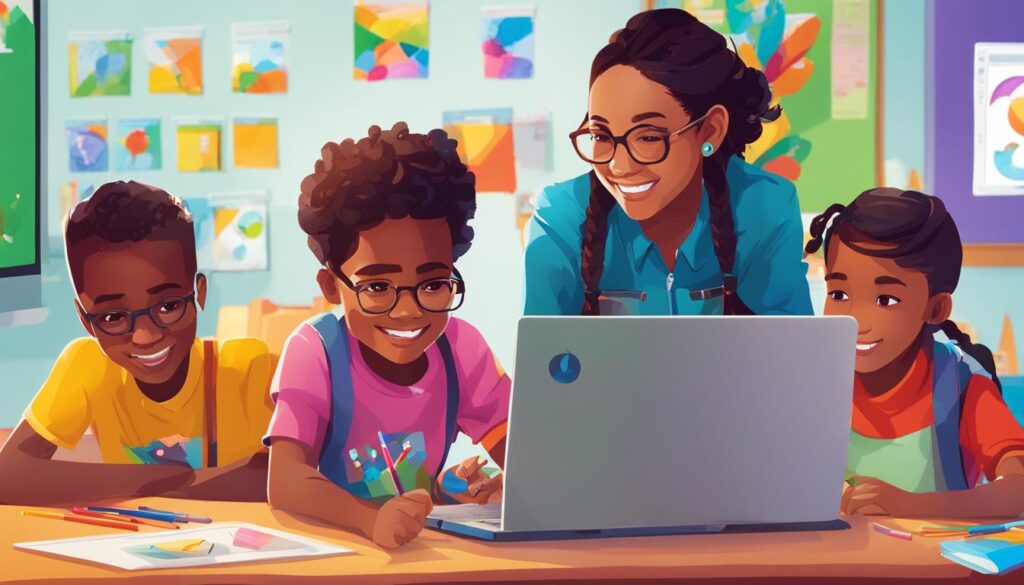
Empowering children through design education not only prepares them for the digital world but also opens doors to exciting career opportunities. It allows them to pursue careers in fields such as graphic design, web design, user experience design, and more. By nurturing their creative abilities and providing them with the necessary skills, we are investing in their future success and helping them become leaders in the design industry.
The Impact of Design Education and Innovative Platforms
Design education and innovative platforms like Schoolopedia have a transformative impact on youth education. These platforms provide structured courses that teach design principles, visual storytelling, and community engagement. Students are challenged to think creatively and embark on a journey of self-discovery, nurturing their creative potential. Design education fosters creative thinking, problem-solving skills, and an understanding of user-centered design. It equips students with technical skills and encourages them to approach problems from different angles. The principles of design become ingrained in their process, empowering them to turn their creative visions into reality.
Through design education, children learn the fundamentals of creative web design, allowing them to develop visually appealing websites that captivate their audience. They are encouraged to explore different styles, colors, and layouts to create engaging website designs optimized for the younger demographic. By combining their technical skills with their creative abilities, children can design websites that not only entertain but also educate and inspire their peers.
Platforms like Schoolopedia provide an interactive and collaborative learning environment, enabling children to connect with like-minded individuals who share the same passion for creative web design. The platform offers various courses and projects that challenge children to think outside the box and push the boundaries of their creative capabilities. By fostering a sense of community, children can learn from their peers, exchange ideas, and gain valuable feedback that helps them refine their design skills.
“Design education is more than just learning how to use design tools. It’s about understanding the power of design to transform ideas into tangible experiences. The combination of technical skills and creative thinking empowers children to become the next generation of innovative designers and problem solvers.”
Design education not only equips children with the skills needed to create visually appealing websites but also instills a sense of responsibility when it comes to user experience. Children learn the importance of designing websites that are intuitive, easy to navigate, and engaging for their target audience. By understanding user needs and incorporating user-centered design principles, children can create websites that provide meaningful interactions and memorable experiences.
With the guidance of design education and the utilization of innovative platforms like Schoolopedia, children can develop a deep appreciation for the art of creative web design. They gain the ability to craft visually appealing websites that not only captivate their audience but also convey their unique ideas and stories. As they continue to refine their skills and broaden their horizons, the impact of design education becomes evident in the visually stunning and engaging websites created by these aspiring young designers.

| Benefits of Design Education and Innovative Platforms | Details |
|---|---|
| Fosters Creative Thinking | Encourages children to think outside the box and explore new ideas |
| Develops Problem-Solving Skills | Equips children with the ability to overcome design challenges and find innovative solutions |
| Promotes User-Centered Design | Teaches children the importance of designing for the needs and preferences of users |
| Cultivates Technical Skills | Provides children with the knowledge and expertise to utilize design tools and technologies |
| Fosters Collaboration and Community | Enables children to connect with peers, share ideas, and gain valuable feedback |
| Empowers Creative Expression | Encourages children to express themselves through visually stunning and engaging website designs |
Conclusion
At WebsiteDesigner.Business, we believe that learning web design at a young age is a powerful tool for empowering kids. Through platforms like Scratch, Minecraft modding, LEGO WeDo, and Web Wonders, children can engage in interactive and fun activities that foster collaboration, creativity, and problem-solving skills. These child-friendly platforms provide a sense of ownership over digital creations, giving kids the confidence to explore their creative potential.
However, design education goes beyond just platforms. Innovative platforms like Schoolopedia enhance the learning experience by guiding students through design principles and offering real-world experience. By equipping kids with creative web design skills, we are preparing them for a future where technology and design play a vital role.
Unlock your child’s creative potential by ordering a web design plan on WebsiteDesigner.Business today. Let us be a part of your child’s journey to develop their creativity, problem-solving skills, and digital literacy. Together, we can empower the next generation to embrace the power of web design and shape the future.
FAQ
What is web design for kids?
Web design for kids refers to the process of creating and designing websites specifically tailored for young audiences. It involves creating visually appealing, interactive, and user-friendly websites that engage children and provide them with a positive online experience.
Why is web design important for kids?
Web design is important for kids because it helps them develop essential skills such as logical thinking, creativity, problem-solving, and digital literacy. It also allows them to express their creativity, share their ideas, and collaborate with others in an online environment.
What are some platforms that offer web design opportunities for kids?
There are numerous platforms that offer web design opportunities for kids, such as Scratch, Minecraft, LEGO WeDo, and Web Wonders. These platforms provide interactive and engaging experiences where kids can learn web design and coding in a fun and creative way.
What is Scratch?
Scratch is a project developed by MIT Media Lab that allows kids to create and share interactive stories, games, and animations on the web. It provides a user-friendly programming environment where kids can control rich media content using graphical programming blocks.
How can kids learn web design through Minecraft?
Kids can learn web design through Minecraft by customizing their Minecraft worlds using modding. By writing code to modify the game, kids can develop logical thinking, creativity, and problem-solving skills while having fun in a familiar and enjoyable environment.
What is LEGO WeDo?
LEGO WeDo is an educational platform that introduces kids to robotics and engineering through hands-on projects. Kids can build their own creations using LEGO elements, motors, and sensors, and program them using an intuitive visual interface.
What is Web Wonders?
Web Wonders is a platform that introduces kids to web development and the basics of HTML and CSS. It provides interactive tools and resources that allow kids to learn about web design, create web pages, and explore the magic of the internet.
What is graphic design and UI/UX design?
Graphic design involves visually conveying messages and engaging audiences through elements such as logos, posters, and websites. UI/UX design focuses on creating intuitive and user-friendly interfaces for digital products and services.
How does design education empower kids?
Design education empowers kids by nurturing their creativity, developing practical skills, and fostering problem-solving abilities. It provides structured learning opportunities and exposure to design communities, allowing kids to gain confidence and pursue careers in design.
Are there any platforms that offer design courses for kids?
Yes, platforms like Schoolopedia offer structured design courses and interactive design challenges for kids. These platforms guide students through the intricacies of design principles and visual storytelling, fostering creativity and self-discovery.
How does learning web design benefit kids?
Learning web design benefits kids by empowering them to develop their creativity, problem-solving skills, and digital literacy. It allows them to express themselves, collaborate with others, and gain valuable skills that are relevant in today’s digital world.
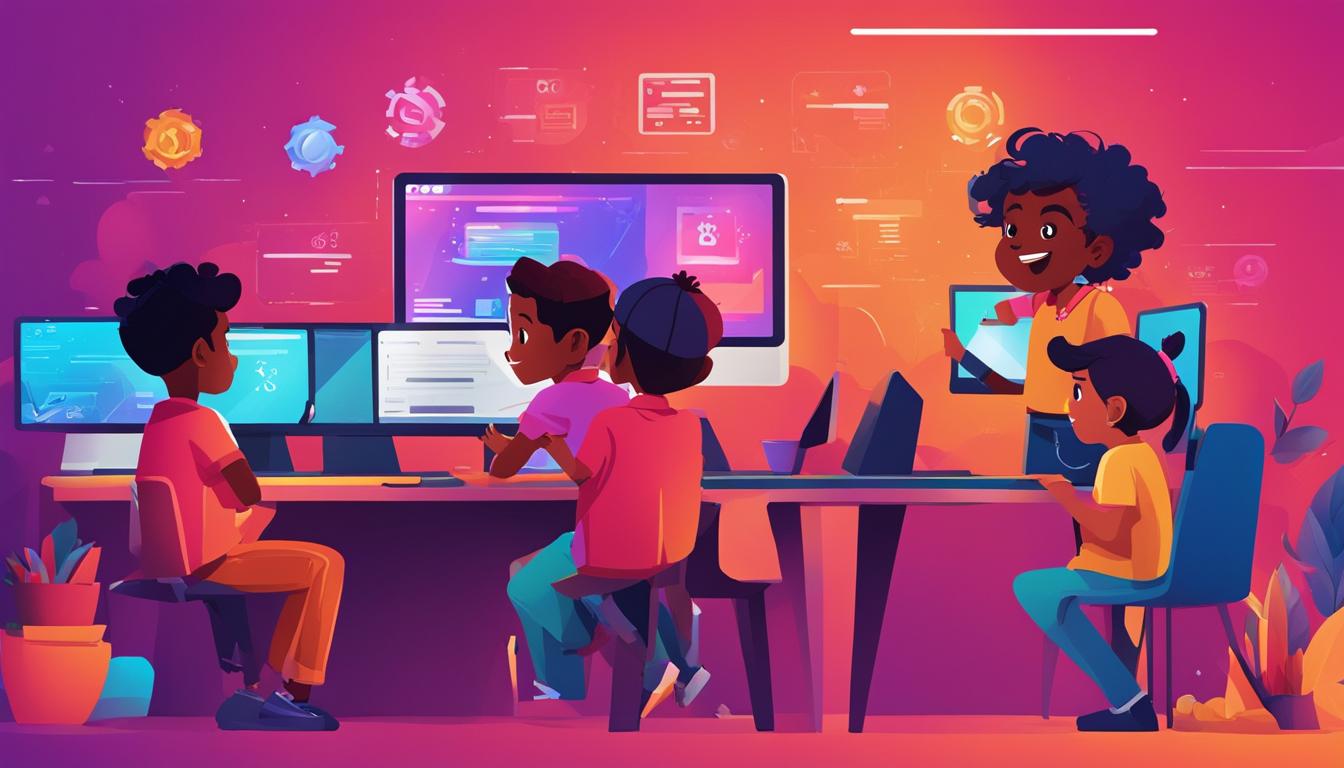
Leave a Reply